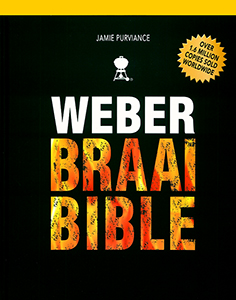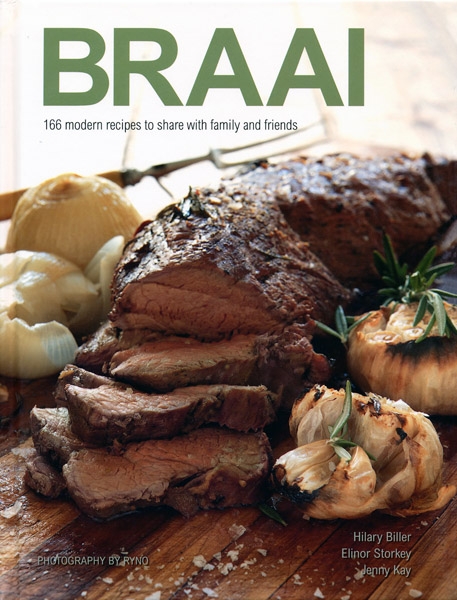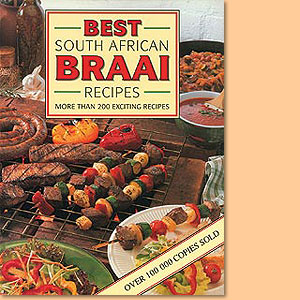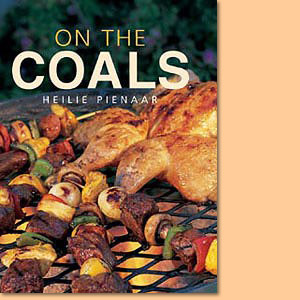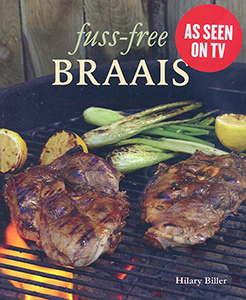Weber Braai Bible, by Jamie Purviance
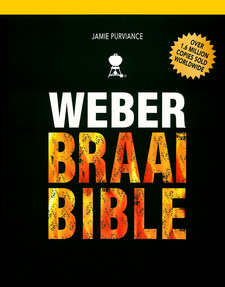
Weber Braai Bible, by Jamie Purviance. Random House Struik Lifestyle. Cape Town, South Africa 2014. ISBN 9781432304072 / ISBN 978-1-4323-0407-2
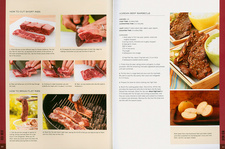
Doubel-side example of step-by-step guidance to expert braaing in Jamie Purviance's Weber Braai Bible (ISBN 9781432304072 / ISBN 978-1-4323-0407-2)
'Braaiing is so tightly woven into South African culture that almost everyone has something to say about the way to do it. All of us have had experiences that help us to be better braaiers. I think what separates the master braaiers from the beginners is really an understanding of the fundamentals.', states Jamie Purviance, author of the Weber Braai Bible.
I wasn't born with a complete understanding and mastery of barbecue techniques. As a kid growing up in suburban America, I had to pick up the basics from my dad and other weekend grillers. Eventually, when it was my turn to grill, I had to imitate what I'd seen and I had to develop my own style by doing what so many others do. I had to improvise. I had to experiment. I had to wing it. Sometimes it worked, and other times... well, it didn't. To be honest, I didn't really learn to barbecue until I was about thirty-years-old. That's when I tackled the subject in a much more methodical way. Obsessed with good food and frustrated by the limitations of winging It, I enrolled at the Culinary Institute of America. There I immersed myself in a rigorous curriculum of the hows and whys of topics like meat butchering, food chemistry, sauce making, and charcuterie. Under the supervision of demanding chefs, I learned serious science-based lessons like how heat affects the structure of meats and fats, how sauces are held together, and how marinades can unravel proteins. Since my graduation some twenty years ago, I've focused my attention on how advanced culinary ideas relate to barbecuing. With the help of many experts at Weber, I've done extensive research on this particular way of cooking and I've written five books on the subject. Each book was an opportunity to learn more about what works on the grill and why some techniques work better than others. This book Is a culmination of all the lessons I've learned. So what is the right way to barbecue? Well, first of all, there isn't just one way to do It. It is not about absolute right and wrong when it comes to issues like gas versus charcoal, direct versus indirect heat, or grilling with the lid on or off. This book Includes and embraces any way to barbecue - as long as It works. And what works best, I've learned, is paying attention to culinary details. There is a big difference between winging It and paying attention. Let me share a couple of examples of what paying attention can do. The first deals with the reason why most steaks turn out beautifully when grilled over direct high heat but most pork chops do not. Why should this be? High heat, of course, can char the surface of meat long before the centre is fully cooked. For a steak, that's a fine result, because you are left with a nicely caramelized outer crust and an interior that is dripping with rosy red juices. A pork chop is another matter. We don't like our pork chops raw in the middle, but if we barbecued most pork chops over direct high heat until the centres were properly cooked, the surfaces would be badly burned. That's why using medium heat is a better way to barbecue most pork chops. It allows the centres to reach an ideal degree of doneness without overcooking the surface. Simple enough, right? But back in my early days, when I was winging it, I threw every kind of meat over the same high heat. That's one reason things did not always work out. A second example about the importance of paying attention deals with something quite fundamental: salt. [...]
This is an excerpt from the cookbook: Weber Braai Bible, by Jamie Purviance.
Title: Weber Braai Bible
Subtitle: The step-by-step guide to expert braaing
Author: Jamie Purviance
Genre: Cookbook
Publisher: Random House Struik
Imprint: Struik Lifestyle
Cape Town, South Africa 2014
ISBN 9781432304072 / ISBN 978-1-4323-0407-2
Hardcover, 22 x 28 cm, 320 pages, 1000 photographs
Purviance, Jamie im Namibiana-Buchangebot
Weber Braai Bible
Weber Braai Bible, winner of the 2014 Gourmand World Cookbook Award, is a groundbreaking compendium on braaing South Africa and Namibia style.
Weitere Buchempfehlungen
Braai
Braai offers a collection of contemporary braai recipes, from beef, lamb, pork, chicken, game and seafood through vegetables, salads, breads and desserts.
Best South African Braai Recipes
Plenty hints and tips to braai chicken, fish and various cuts of meat
Braai Buddy 2
For those who are tired of braaiing the same ways, Braai Buddy 2 is a seriously different book on braaiing.
On the Coals
On the Coals is an innovative new collection of South African braai recipes and ideas for the keen outdoor cook.
Fuss-free Braais
Fuss-free Braais proivdes interesting new braaing ideas, to prepare outdoors on a gas, wood or charcoal fire.

